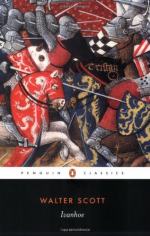|
This section contains 15,349 words (approx. 52 pages at 300 words per page) |

|
SOURCE: "Writing Nationalist History: England, the Conversion of the Jews, and Ivanhoe," in ELH, Vol. 60, No. 1, Spring, 1993, pp. 181-215.
In the following essay, Ragussis argues that Scott's depiction of the conflict between Jewish and Anglo-Saxon traditions suggests that history proceeds through the synthesis of cultures rather than the preservation of homogeneous racial identity.
I: "the Crisis of All Nations"
While Scott was writing his first medieval novel in the summer and fall of 1819, the revival of medievalism in the German states was taking a particularly noxious form. The rise of German nationalism, crystallized by the expulsion of the French after the defeat of Napoleon, climaxed in the famous anti-Semitic persecutions known as the "Hep! Hep!" riots. The idea of Christian medievalism became realized in these persecutions when the rioters reiterated the cry of the Crusaders who massacred the Jews in 1096.1 The direct impact of these anti-Semitic persecutions on...
|
This section contains 15,349 words (approx. 52 pages at 300 words per page) |

|


